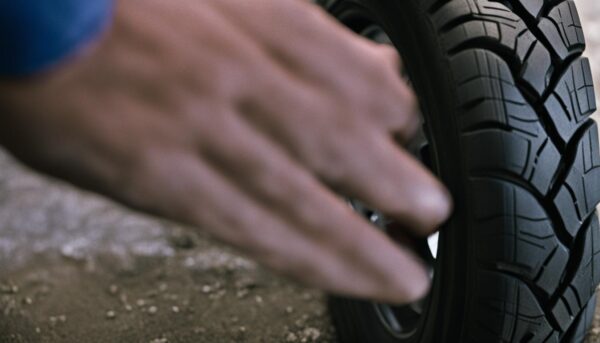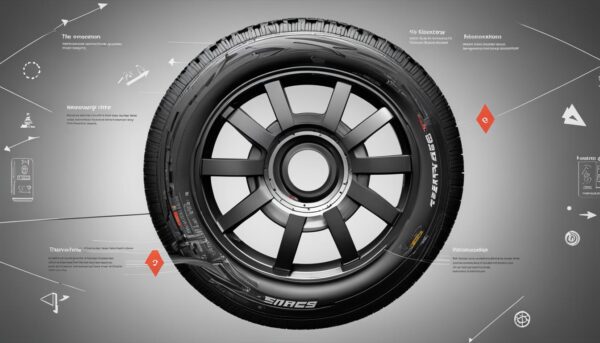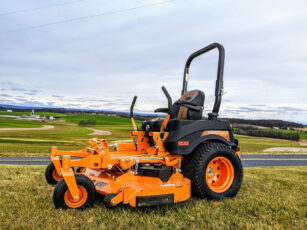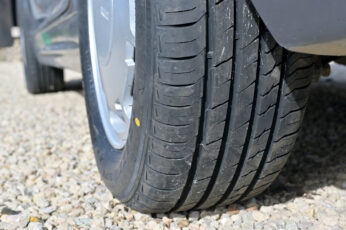Last Updated on 8 months
Ensuring Road Safety: Your Step-by-Step Guide to Checking Tire Safety
Conducting a tire safety check is a quick and essential task all vehicle owners should do regularly. Proper tire inspection and maintenance help ensure your tires remain safe and reliable and contribute to a smooth, fuel-efficient ride. This guide will discuss the different aspects of tire maintenance, including checking tread depth, tire pressure, tire condition, and more.
Key Takeaways
- Maintain proper tire pressure for optimal performance and fuel economy.
- Measure tread depth using the penny test to know when to replace tires.
- Monitor tire condition and appearance for any visible damage or signs of excessive wear.
- Rotate tires every 5,000 to 8,000 miles to ensure even wear and prolong their life.
- Check tire alignment to prevent uneven wear and potentially dangerous situations.
- Perform pre-trip inspections on long road trips to ensure tire safety.
- Be mindful of heat-induced tire issues during extended drives, particularly during summer.
Understanding the Importance of Regular Tire Checks
Establishing a routine for regular tire inspections is crucial to maintaining your vehicle’s overall performance and safety. Detecting problems early on could prevent potential accidents due to tire failure and extend the life of your tires.
Boosting Safety with Tire Maintenance
Regular tire safety inspections help ensure the safety of all the passengers in your vehicle. By performing these routine checks, you can spot issues with your tires, such as unusual wear patterns or damage, that could lead to unsafe or inconvenient situations, particularly when driving at high speeds or in intense heat and inspecting your tires at least once a month and before long trips are recommended to lessen the chances of unexpected tire-related incidents.
Maintaining a tire maintenance routine is essential to promoting a safe and secure driving experience.
Improving Fuel Economy through Proper Tire Care
One often overlooked aspect of tire care is its impact on your vehicle’s fuel economy. Proper tire maintenance can significantly improve your vehicle’s efficiency, helping reduce your overall fuel costs.
- As the manufacturer recommends, check tire pressure monthly to ensure proper inflation.
- Underinflation can lead to increased tire flex, heat buildup, and faster wear, negatively impacting fuel efficiency.
- Properly inflated tires ensure a smoother, more fuel-efficient ride.
| Maintenance Task | Frequency | Benefits |
|---|---|---|
| Tire pressure check | Monthly | Improved fuel efficiency, prolonged tire life |
| Tir regular car maintenance rotation | Every 5,000-8,000 miles | Even tire wear, extended tire life |
| Tire alignment | As needed (if uneven wear is spotted) | Prevents uneven wear, improved handling |
Implementing these tire safety tips into your regular car maintenance routine ensures a safer, more efficient driving experience for you and your passengers.
Inspecting Tread Depth for Optimal Traction
One of the critical aspects of tire inspection is assessing the tire tread depth. Ensuring your tires have an adequate tread depth will provide optimal traction and enhance safety on the road. Two popular methods to check the tire tread depth are the penny test and interpreting tread wear indicators.
Remember: The legally prescribed minimum tire tread depth in the United States is 2/32 inches.
Conducting the Penny Test
The penny test is quick and straightforward to check your tire’s tread depth. The test utilizes a penny coin that can tell you whether your tires meet the legal minimum requirement for tread depth (2/32 inches).
- Hold the penny so the top edge is between your thumb and index finger, with Lincoln’s head facing downwards.
- Insert the penny into one of your tire’s tread grooves with Lincoln’s head pointing toward the tire.
- Closely observe the exposed portion of Lincoln’s head. If the top of his head is visible, the tire’s tread depth is below 2/32 inches, indicating a need for new tires.
Note:
For optimal safety and performance, it is recommended that you consider replacing your tires when they reach a tread depth of 4/32 inches.
Interpreting Tread Wear Indicators
Tread wear indicators or wear bars are raised features within the tire grooves designed to signal when the tire is no longer safe. As the tire gets worn, the tread wear indicators flush with the tire tread. When this occurs, the minimum legal tread depth of 2/32 inches has been reached, and you should replace your tire.
| Tread Wear Indicator Status | Remaining Tread Depth (Approx.) | Recommended Action |
|---|---|---|
| Tread wear indicators are not flush with the tread | More than 2/32 inches | Continue monitoring during regular tire inspections |
| Tread wear indicators are flush with the tread | 2/32 inches | Replace tire (legally unsafe) |
| Tread wear indicators have not yet reached a flush point | Around 4/32 inches | Consider replacing the tire for optimal safety and performance |
In conclusion, regularly inspecting your tire tread depth using the penny test and interpreting tread wear indicators is essential for tire safety and performance. Adequate tire tread depth ensures optimal traction and handling, providing a safe and comfortable driving experience.
Mastering Tire Pressure Checks for Maximum Performance
Proper tire pressure is essential for optimal vehicle performance, safety, and maintaining the longevity of your tires. Knowing how to check and maintain tire pressure using a tire gauge accurately can make all the difference.
For an accurate tire pressure check, take the reading when tires are cold, meaning they have not been driven on for at least one hour. This is because driving, even for short distances, heats the tires and causes the pressure to increase temporarily.
- Locate the manufacturer’s recommended tire pressure level in your vehicle’s owner manual or the driver’s side doorjamb. Please do not rely on the value provided on the tire’s sidewall, as it indicates the maximum pressure the tire can safely handle, not the recommended pressure for your vehicle.
- Remove the tire’s valve cap and place the tire gauge on the valve stem, ensuring it is seated properly and no air is escaping.
- Read the pressure shown on the tire gauge and compare it to the recommended level from the manufacturer.
- If the pressure is too low, add air until the correct pressure is reached. If the pressure is too high, release some air until the desired level is met.
- If applicable, repeat this process for all four tires, including the spare.
Remember, maintaining tire pressure is crucial for preventing underinflation, which can lead to tire flex, heat buildup, and premature failure.
| Tire Safety Inspection | Frequency |
|---|---|
| Inspecting tire pressure and adjusting as necessary | At least once a month |
| Performing full tire safety inspection, including tread depth and condition | Every 5,000 to 8,000 miles |
| Rotating tires | Every 5,000 to 8,000 miles, or as per your vehicle’s owner manual-specific recommendation |
Regularly conducting tire safety inspections and maintaining tire pressure can help prolong tire life and improve overall vehicle safety. By mastering tire pressure checks and adhering to suggested schedules, you’ll ensure a smoother, more fuel-efficient drive while minimizing your risk of encountering tire-related issues.
Evaluating Tire Condition and Detecting Wear and Tear

During a tire safety check, a thorough evaluation of tire condition is crucial to catch potential issues and ensure a safe driving experience. By paying attention to the sidewalls and looking for signs of unusual wear and tear, you can prevent unexpected tire failure and increase the lifespan of your tires.
Assessing Sidewall Integrity
Sidewall integrity is significant in maintaining tire safety and prolonging tire life. Inspecting the sidewalls for visible damage, such as cracks, cuts, bulges, and other irregularities, is an essential aspect of a tire wear inspection. This damage can weaken the tire structure, leading to tire failure and compromising your safety on the road.
Spotting Signs of Potential Tire Damage
Beyond assessing sidewall integrity, it’s imperative to spot signs of potential tire damage, including cuts, punctures, bulges, bumps, or cracks on both the tread and sidewalls. Such damage may result from encounters with potholes, debris, or curbs, and any visible abnormalities warrant a professional inspection and potentially a tire replacement.
By following the guidelines listed in the table below, you can effectively detect common issues during a tire wear inspection:
| Signs of Tire Damage | Possible Causes | Action to Take |
|---|---|---|
| Cracks or cuts in the sidewall | Exposure to sunlight, aging, or physical damage | Professional appraisal and possible tire replacement |
| Bulges or bumps | Internal tire damage or hit by a hard object | Professional appraisal and possible tire replacement |
| Punctures or visible nails | Road hazards | Immediate repair or tire replacement, depending on the severity |
| Cracks on the tread | Excessive wear or aging | Professional inspection and possible tire replacement |
| Uneven wear patterns | Misalignment, unbalanced tires, or insufficient tire rotation | Proper alignment, balancing, or rotation |
“Preventive tire maintenance is key to ensuring a safe and pleasant driving experience.”
By regularly evaluating your tire’s condition and detecting wear and tear during a tire wear inspection, you can maintain optimal tire safety and prolong the life of your tires, contributing to a safe and enjoyable driving experience.
Monitoring Tire Age and Understanding Replacement Timelines
The age of your tires plays a significant role in their performance and safety on the road. To ensure your vehicle remains safe and reliable, tracking your tires’ age and understanding when to replace them is essential. Alongside tread wear and damage, age can contribute to tire degradation over time.
To monitor the age of your tires, check the sidewall for the DOT code, a series of letters and numbers. The last four digits of the code indicate the week and year of manufacture. For example, a code ending in “0421” would mean the tire was manufactured in the 4th week of 2021.
Keep in mind that tire manufacturers and auto industry experts recommend replacing tires no more than ten years after their manufacture date. However, some manufacturers might advise replacing them at six years, regardless of tread wear, due to potential degradation over time.
Following the tire replacement timelines recommended by the tire manufacturer or your vehicle’s owner manual is essential to ensure tire safety and performance. The following table provides a general overview of when to consider replacing your tires based on age.
| Years Since Manufacture | Action |
|---|---|
| 0-5 | Regular inspections and maintenance |
| 6 | Check manufacturer recommendations or consult with a professional for possible replacement |
| 7-9 | Consider replacing tires to ensure optimal performance and safety |
| 10+ | Replace tires, regardless of the remaining tread depth |
Besides age, inspecting your tires regularly for signs of wear and damage is crucial. Combined with tire maintenance practices like proper inflation and rotation, monitoring your tires’ age and following manufacturer replacement guidelines will contribute significantly to maintaining safe, reliable, and optimally performing tires.
The Role of Tire Rotation in Prolonging Tire Life

Tire rotation is a crucial tire safety tip in prolonging tire life and maintaining consistent performance. Regularly rotating tires can ensure even wear across all four tires, leading to better vehicle handling and longer-lasting tires.
Regular tire rotations can extend the life of your tires, improve fuel efficiency, and contribute to a smoother, safer ride.
When and How to Rotate Your Tires
Rotating your tires every 5,000 to 8,000 miles or as stated in the vehicle owner’s manual is generally recommended. Keeping track of your mileage and sticking to the recommended tire rotation schedule can help preserve your investment in high-quality tires.
A tire rotation involves following the proper pattern as the vehicle manufacturer advises. Various rotation patterns exist depending on your vehicle’s drivetrain (front-wheel drive, rear-wheel drive, or all-wheel drive) and tire size. Some common patterns include:
- Front-to-rear
- X-pattern
- A modified X-pattern
- Side-to-side
You can rotate your tires or do it professionally at a tire service center. Whichever route you take, you must ensure the rotation pattern is appropriate for your specific vehicle to achieve the desired outcome of even tire wear and prolonged tire life.
| Drivetrain | Pattern | Description |
|---|---|---|
| Front-wheel Drive | Forward Cross | Move the front tires straight back and the rear diagonally to opposite front corners. |
| Rear-wheel Drive | Rearward Cross | Move the rear tires forward and the front diagonally to opposite back corners. |
| All-wheel Drive | Four-Tire Rotation | Move the front tires to the rear and rear tires to the front, staying on the same side of the vehicle. |
By following the guidelines for tire rotation, you can protect your tires from premature wear and promote a safer driving experience. Always refer to your owner’s manual for specific guidance on tire rotation practices for your vehicle.
Ensuring Proper Tire Inflation and Its Benefits
Proper tire inflation maximizes vehicle performance, fuel economy, and tire lifespan. By checking tire pressure monthly and comparing it with the manufacturer’s recommended levels, you can help maintain optimal tire condition. It is important to note that tire pressure recommendations are usually found on the driver’s doorjamb sticker, not on the tire sidewall.
There are numerous benefits of proper tire pressure, some of which are outlined below:
- Enhanced fuel efficiency
- Improved vehicle handling and stability
- Even tire wear, resulting in longer tire life
- Reduced risk of tire-related accidents
- Decreased tire maintenance costs
A reliable tire pressure gauge is crucial to maintain proper tire inflation. This will enable you to check tire pressure accurately and make necessary adjustments. Regular tire maintenance, including pressure checks and adjustments, can significantly affect your vehicle’s overall health, performance, and safety.
Maintaining proper tire pressure not only helps ensure a safer and more efficient driving experience but also helps extend the life of your tires.
| Underinflated Tires | Properly Inflated Tires |
|---|---|
| Increased tire flex and heat buildup | Optimized tire stiffness and reduced heat |
| Faster wear and reduced tire life | Even wear and extended tire life |
| Reduced fuel efficiency | Improved fuel economy |
| Poor vehicle handling and stability | Enhanced vehicle handling and stability |
| Higher risk of tire-related accidents | Lower risk of tire-related accidents |
| Increased tire maintenance costs | Decreased tire maintenance costs |
In conclusion, ensuring proper tire inflation is crucial for optimal vehicle performance, fuel efficiency, and safety. Remember to check your tire pressure monthly and adjust it according to the manufacturer’s recommendations for a smoother, safer driving experience.
Checking Tire Alignment to Prevent Uneven Wear
One crucial aspect of maintaining your tires is checking tire alignment, which significantly prevents uneven wear and prolongs your tires’ lifespan. Uneven tire wear can indicate wheel misalignment, often caused by hitting a pothole, curb, or other road debris. Proper tire alignment ensures an even weight distribution across the tire and reduces the chances of premature wear.
While a tire inspection can help spot uneven wear, having a professional assess your tires and fix alignment issues is best. Trained technicians use specialized equipment to inspect and adjust your vehicle’s suspension and steering components, ensuring proper tire alignment and preventing uneven tire wear.
Always realign your tires after fitting new ones to ensure even tread wear and optimum performance.
Some common signs indicate misaligned tires, such as:
- Uneven or rapid tire wear
- Vibration in the steering wheel
- The steering wheel is off-center when driving straight
- Vehicle pulling to one side
Here are some preventive measures to maintain proper tire alignment and avoid uneven wear:
- Perform regular tire maintenance such as rotation, balancing, and checking inflation pressure.
- Drive carefully and avoid curbs, potholes, or any objects that can damage the suspension and steering components.
- Inspect your tires for signs of uneven wear during routine maintenance and seek expert help if needed.
In conclusion, keeping your tires properly aligned is a critical aspect of tire maintenance that helps prevent uneven wear and ensure the longevity of your vehicle’s tires. Include tire alignment checks in your regular tire inspection routine to keep them in the best possible condition for safe and enjoyable driving.
Addressing Tire Safety on Long Road Trips
Long road trips often present unique challenges to tire performance and safety. Ensuring optimal tire conditions before hitting the road is essential to prevent unexpected issues and guarantee a smooth, secure ride. Let’s explore some vital aspects of tire safety during extended journeys and how to handle them effectively.
Performing Pre-Trip Inspections
Before embarking on any long road trip, conducting a comprehensive pre-trip tire inspection is crucial. This process involves:
- Checking tire tread depth for efficient traction
- Evaluating tire pressure to ensure proper inflation levels
- Examining wear patterns for signs of uneven wear or potential alignment issues
- Assessing sidewall condition for visible damage, such as cracks, cuts, or bulges
Conducting a thorough tire inspection before a long journey can help identify and address potential issues before they escalate, significantly enhancing your safety and comfort during the trip.
Identifying Heat-Induced Tire Issues
Extended high-speed drives can exacerbate heat-induced tire issues. These problems may include:
- Increased tire pressure due to heat expansion
- Worsening of existing damage, potentially leading to tire failure
- Expedited wear, reducing tread depth quicker than anticipated
Inspecting your tires during long road trips for visible heat-induced damage is essential. Furthermore, once the journey is complete, a post-trip inspection can provide valuable insights into any consequences of prolonged heat exposure and help you take appropriate action if needed.
Remember, tire safety is a critical aspect of your overall road trip experience. Make it a priority to perform pre and post-trip inspections to keep your vehicle in top-notch condition and enjoy a smooth, worry-free journey.
Taking the necessary precautions and regularly inspecting your tires will create a safer driving environment for you and your passengers while protecting your investment in your vehicle’s tires. Tire inspection and maintenance during long road trips are vital in providing a secure and enjoyable driving experience.
Conclusion
Performing a tire safety check is crucial to vehicle maintenance, promoting the tires’ and vehicle’s safety and longevity. By inspecting tire tread depth, tire pressure, tire condition, and more, individuals can help maintain safe and reliable tires that contribute to optimal vehicle performance.
Regular tire maintenance, such as checking tire pressure and alignment, can keep you safe on the road and help you save money on fuel costs by improving fuel economy. Additionally, monitoring the age of your tires and following the recommended tire replacement timelines can help you avoid potential risks associated with using old or worn-out tires.
In conclusion, conducting regular tire safety checks and implementing a tire maintenance routine is a small but essential investment in ensuring vehicle safety. While it may seem like a minor task, the benefits of preventing tire-related issues and prolonging the life of your tires cannot be overstated.
FAQ
How often should I perform a tire safety check?
Perform a monthly tire safety check before long road trips to ensure optimal safety and performance.
How do I check my tire’s tread depth for optimal traction?
Use the penny test by inserting a penny upside down into the tire tread. If you can see the top of Lincoln’s head, it’s time for new tires. Tread depth should be more than 2/32 inches for safety.
How do I check my tire pressure for maximum performance?
Use a tire pressure gauge and compare the reading to your vehicle’s recommended pressure, ideally when the tires are cold. Ensure proper inflation as per the vehicle manufacturer’s recommendations.
How do I evaluate my tire’s condition and detect wear and tear?
Assess sidewall integrity by looking for cracks, cuts, bulges, or other damage. Additionally, check the tread for signs of scratches, punctures, lumps, bumps, or cracks. Address any visible abnormalities before they become more severe.
When should I replace my tires?
Replace tires when the tread is worn down to 2/32 inches, when a tire reaches ten years of age (or six years, depending on the manufacturer’s recommendation), or when the sidewall is damaged with visible cracks, cuts, or bulges.
How often should I rotate my tires, and why is it important?
Rotate your tires every 5,000 to 8,000 miles per your owner’s manual. Tire rotation is essential for maintaining even wear and prolonging tire life.
How can I ensure proper tire inflation, and what are its benefits?
Check tire pressure monthly with a gauge and compare it to the manufacturer’s recommended levels on the driver’s doorjamb sticker. Proper tire inflation enhances performance, fuel economy, and tire lifespan.
How do I check tire alignment, and why is it important?
Inspect your tires for uneven wear patterns, which can indicate wheel misalignment. Have a professional assess and realign your tires when needed. Proper tire alignment helps prevent uneven tread wear and extends the life of your tires.
What should I pay attention to regarding tire safety on long road trips?
Perform a pre-trip inspection by checking tread depth, tire pressure, wear patterns, and sidewall condition. Be mindful of heat-induced tire issues during extended high-speed drives, such as increased tire pressure and expedited wear. Inspect tires after a long trip as well to ensure their condition.













 Français
Français Español
Español